The following is an excerpt from the new book Anvils, Mallets & Dynamite: The Unauthorized Biography of Looney Tunes © 2021 by Jaime Weinman. Reprinted by permission of Sutherland House Books.
Robert McKimson was not one of the very greatest Looney Tunes directors, but in two decades of directing cartoons for Warner Bros., he created a number of memorable characters. The most high-concept one of the bunch was Hippety Hopper, a baby kangaroo that Sylvester the cat mistakes for a giant mouse. He was the creator of Speedy Gonzales, though his original version was very different from the one who became famous. He created the Tasmanian Devil, who became a marketing phenomenon and got his own TV cartoon. But his signature creation is Foghorn Leghorn, the man-size chicken. He may not be as big as Bugs Bunny, but audiences have loved him ever since he first appeared in “Walky Talky Hawky,” a film nominated for an Academy Award. McKimson continued to release at least one Foghorn cartoon every year until the studio shut down.
One of the famous factoids about Foghorn is that he talks a lot like Senator Claghorn, the pompous Southern senator played by Kenny Delmar on radio’s The Fred Allen Show. He’s not actually a knockoff of Senator Claghorn. The dialogue track for his first cartoon was recorded in early 1945, several months before Delmar introduced the Claghorn character. McKimson said that both the chicken and the senator were based on an older radio character, a sheriff played by Jack Clifford on the West Coast radio program Blue Monday Jamboree, who had a tic of repeating his words and prefacing them with “I say” (“I believe, I say I believe …”). Because animated cartoons took a long time to complete and be released, “Walky Talky Hawky” didn’t debut until 1946 and, by then, he seemed like a Claghorn clone.
McKimson and his team didn’t seem to mind the association, and began to make him more like Delmar’s character. They took up some of Claghorn’s verbal characteristics, like adding “that is” to the end of sentences (“Yes, dreamboat,” Foghorn says to his wife in the one cartoon where he has a wife, “… tugboat, that is”). The chicken was given the name “Foghorn” to suggest a similarity to the Fred Allen Show character, and Mel Blanc shifted toward a Southern accent, which wasn’t used in Foghorn’s first couple of appearances.
Foghorn was an example of how attempts to create a star don’t always lead to predictable results. The star of “Walky Talky Hawky,” until Foghorn stole the series from him, was a young New York–accented chicken hawk named Henery, who had been created by director Chuck Jones several years earlier. The premise for the first few years is that Henery tries to catch his first chicken, and goes to a farm where Foghorn is engaged in a prank war with a gravel-voiced barnyard dog. The signature gag of the series is Foghorn hitting the dog’s butt with a wooden paddle, followed by the dog chasing Foghorn and accidentally self-strangulating on his tether. Henery plays off the rivalry between Foghorn and the dog, and a typical ending will have Henery dragging Foghorn away to be eaten, or, in one case, just watching while the chicken and dog fight it out: “I don’t care who wins, I’ll fricassee the loser!”
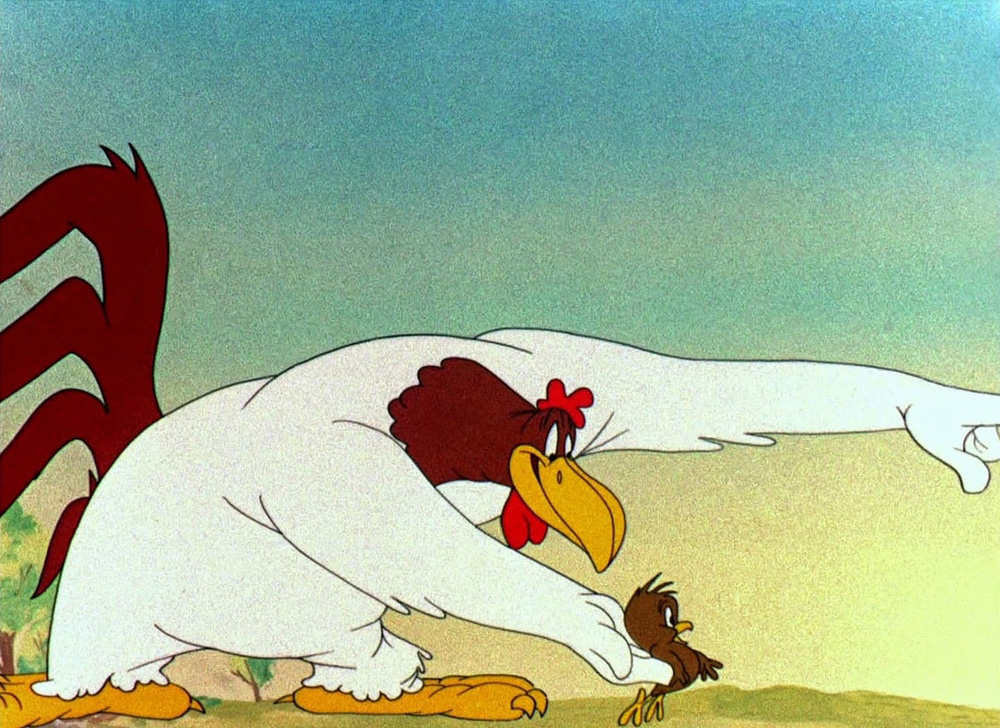
This isn’t quite like any other Looney Tunes series setup, but then Foghorn is not quite like any other Looney Tunes star. He allowed McKimson to stake out territory that none of the other directors had covered. Most characters fell pretty neatly into the dynamic of predator and prey, like Elmer Fudd and Bugs Bunny or Wile E. Coyote and the Road Runner: their behavior could be justified because they were hungry, or because they wanted to save their own hide. Foghorn rarely fights for his survival, and because he’s so huge, no one seems like a physical threat to him, although they sometimes turn out to be stronger than he expected. He’s not a nice person. He will often encourage other characters to make trouble, either for his own amusement at watching them fail, or to complicate the dog’s life. But while not a hero, Foghorn isn’t a nihilistic screwball like the early Daffy Duck, either. He’s sane and quite mellow. His stock poses have him leaning nonchalantly on something, wordlessly singing the Stephen Foster song “Camptown Races,” which became the theme music for most of his later cartoons.
Foghorn also has his own approach to violence. Compared to Bugs Bunny or Daffy Duck, he uses less of it. In the fourth Foghorn cartoon, “Henhouse Henery,” the dog is chasing Foghorn in retaliation for another prank, Foghorn chops down a tree, carries it into a conveniently located woodworking workshop, and uses the equipment to turn the tree into a baseball bat, all in about 10 seconds of screen time. This is a classic Warner Bros. gag, where the joke is not what happens but the absurdly small amount of time it takes to do it: cartoon characters change costumes, bake cakes and construct entire buildings in the time it takes for the audience to finish its next laugh. But the baseball bat is the most violent weapon Foghorn gets hold of in the cartoon, and he doesn’t even actually get a chance to use it. The dog grabs it away from him, and the chase continues.
There are some cartoons, particularly later ones, where dynamite and guns come into play, but those gags often don’t feel right for the series. Foghorn is about paddles, baseball bats and Rube Goldberg contraptions assembled from the junk lying about the farmyard. If most Looney Tunes cartoons take place in the modern world, complete with the constant threat of being blown to smithereens, Foghorn Leghorn cartoons feel like they take place in an old-fashioned America. Not urban like Bugs or suburban like Elmer Fudd, Foghorn Leghorn and the dog are from the old America that urbanites and suburbanites love to revisit in their stories and sitcoms, a place where life revolves around the farmyard and the fishing hole.
By Looney Tunes standards, there is even a bit of continuity in Foghorn’s cartoons, since he and the dog are almost always portrayed as having a pre-existing rivalry, and the cartoons rarely take place anywhere but on a farm, or in a yard resembling a farm. But what really separates Foghorn from most of his stablemates is the low-stakes world he lives in. Most Looney Tunes characters are driven by the desire to survive or the urge to win. Foghorn is usually driven by boredom: not ours, but his. He gives the impression of being a smart, talkative guy stuck on a farm, where there is no one to talk to except other chickens and a dim-witted dog. He’ll troll Henery, who rarely knows what a chicken looks like, by sending him after other animals, telling him that they’re chickens. Sometimes he’ll let predators loose on the farm, or team up with them, just to stir up trouble and keep himself entertained in this idyllic but dull farm life.
As antiheroes go, Foghorn is more relatable than the early Daffy. He is someone trapped in a mundane world willing to do pretty much anything to occupy his time. If you think of the farmyard as an office and Foghorn and the dog as employees with too much time on their hands, the popularity of the series makes sense. Foghorn is a jerk and mostly a loser, but, like characters on The Office, we forgive him because, within the limitations of his world, he’s finding ways to have the fun denied so many of us.
Another popular feature of Foghorn’s cartoons is his dialogue. Most Looney Tunes characters have fairly minimal dialogue. Even Bugs will say nothing for long stretches of a cartoon. There was a taboo against having characters stand around and talk for a second longer than the plot required, because that reduced a scene to illustrated radio, carried by words, not drawings. But Foghorn is a radio-derived character and a motormouth. This was, perhaps, a limitation: when Foghorn isn’t talking, he doesn’t quite seem like himself (even his body language tends to emphasize the rhythm of his words). At least it set him apart from other characters who were clearly rooted in the silent era.
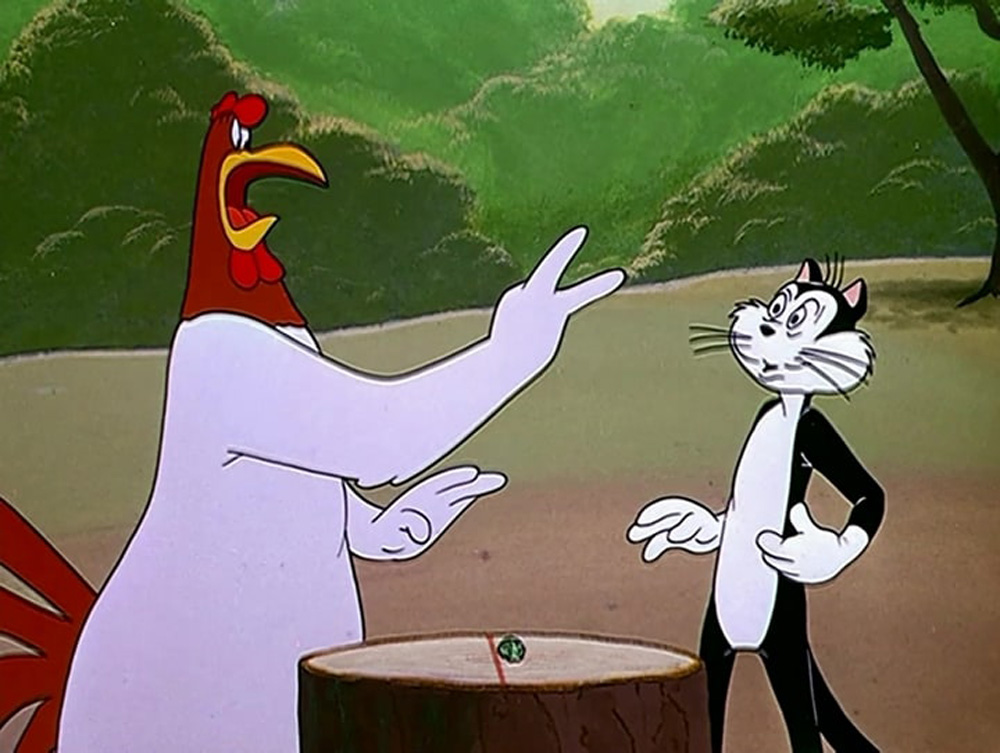
“A Fractured Leghorn” (1950) is a milestone cartoon for the character. It shows him refusing to stop talking and accusing everyone else of not letting him get a word in edgewise. It is also the first Foghorn cartoon without Henery or the dog, and the first that showed he could exist within a different plot. The setup is one that McKimson’s writer, Warren Foster, used in many Tweety cartoons: two big characters are competing to eat a tiny creature, and they alternate between chasing the creature individually, chasing him together, and just beating each other up. Here the big guys are Foghorn and an unnamed black-and-white cat, similar to Sylvester but designed by McKimson’s unit. They’re both after a worm, although for different reasons: Foghorn wants to eat the worm and the cat needs bait to catch a fish.
This setup allows for variations on predator/prey gags, most of which could probably have been done with other characters. What makes the cartoon distinctively Foghorn is that he will not stop talking at the cat. The worm doesn’t talk, and the cat doesn’t, either, until the very end, so the dialogue track is a running Foghorn monologue of Claghorn-esque insults (“Boy’s got a mouth like a cannon, always shootin’ it off.”), irrelevancies (“There’s no oil five hundred miles of here! Geology of the ground’s all wrong! Even if there was oil, you’d need a drill, not a tire pump!”) and anything else that can keep his opponent distracted. The animation has him constantly in motion, walking while he talks, pushing and slapping the cat, and blaming him for being pushed and slapped, and generally acting like he doesn’t care about eating the worm as much as he cares about ruling the conversation.
Foghorn is so in love with the sound of his own voice that at the end of the cartoon, he simply lets the worm get away because he’s too busy lecturing the cat on why, by his logic, the worm was not actually there to begin with (“That’s mathematics, son! You can argue with me, but you can’t argue with figures!”). Finally, driven too far, the cat clobbers Foghorn with a garbage can and speaks his only words of the film: “AH, SHUT UP!” using a Mel Blanc line delivery that was so iconic that directors used it for multiple characters over the years. As the cat walks away, Foghorn embarks on a long monologue about how he always stops talking when asked, and physically holds back the screen from going black just so he can squeeze in a few more lines about how little he talks.
The series evolved away from the original formula and was allowed free range. One of the refreshing things about the Foghorn Leghorn series is how un-formulaic it is by the usual Warner standards. Some shorts have Foghorn trying to fend off the advances of Miss Prissy, a spinster hen in a bonnet who rarely says anything but “Yeeeessss,” inflecting it differently depending on her mood. Others feature an outside predator, like a fox or a weasel, trying to catch the chickens on the farm, noticing that Foghorn and the dog are the worst henhouse guardians on the planet. And there are cartoons that cross over into sitcom territory, like a visit from Foghorn’s obnoxious old college buddy. Not all these stories worked as well as the original setup but Foghorn remained a consistently funny character, even after McKimson lost Foster: the senior director at the studio, Friz Freleng, managed to get Foster transferred to his unit, with Freleng’s ex-writer, Tedd Pierce, going to McKimson. Pierce had written many good cartoons, but it was unquestionably a demotion.
Pierce was good at structure, at finding ways to sustain viewer interest during the early part of a cartoon, the setup, where cartoons are often slow. And he was good at dialogue, with Foghorn’s one-liners coming easy to him. But as a creator of gags, he was weaker than Foster. Faced with the need to come up with six minutes’ worth of material, he and McKimson often fell back on overfamiliar stock bits: characters crashing through a wall and leaving an outline of themselves; women hitting men on the head with rolling pins. Pierce was also what used to be known as a “colorful character,” which meant that he had a drinking problem, got into fights in his spare time and once got bit on the ear by a monkey at the bar across the street from the studio.
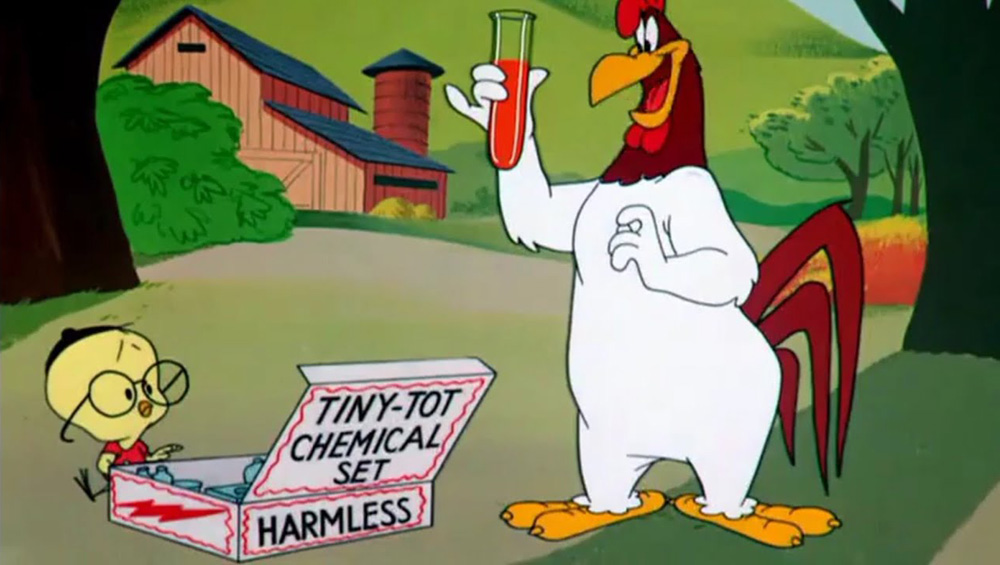
Along with the change in writing, the changing art styles of the period had their effect on Foghorn. It was no longer fashionable to have characters overact physically the way Foghorn did in “A Fractured Leghorn,” and McKimson started to guide his animators toward a more subtle style that resembled his own. This, in turn, affected Foghorn’s dialogue. In keeping with his more restrained movements, Foghorn stopped being a motormouth and became more of a snarker.
The new, more sitcom-ish Foghorn worked best when he had a situation that could rattle him and give him opportunities for good one-liners. One of the best of the period was 1954’s “Little Boy Boo,” written by Pierce, where Foghorn is trying to romance Prissy by ingratiating himself with her nerdy son. The cartoon is unforgettable first for the amazing design of the son: a chick with an enormous round head, two beady black eyes, gigantic glasses that don’t seem to have any lenses in them, and a hat that belongs to a schoolchild of an earlier era. He never talks, he walks rigidly and rarely changes expression. He’s like Tweety after a growth spurt and too many science classes.
Most of the gags in the film proceed from a basic premise: Foghorn tries to get the kid to play, whether at baseball, paper planes or hide-and-seek. The boy participates, but does so by making complicated mathematical calculations that teach him how to hit, throw and, in one scene, build a paper plane that literally shoots Foghorn’s plane out of the sky. This plays to Pierce’s strengths at writing variations on a single gag, and it also works for the animators. Rod Scribner, the king of bizarre squash-and-stretch animation, has mostly toned down his style for the new Foghorn, but here he gets to go wild when a baseball is hit down Foghorn’s throat.
The most famous gag in the picture, and one of the most famous in the entire Looney Tunes canon, has Foghorn and the boy playing hide-and-seek. Foghorn hides in a feed box, commenting that the kid “will need a slide rule to find me in here.” Of course, the kid uses a slide rule to calculate Foghorn’s location (confounding generations of children raised on digital technology). Based on his calculations, the boy walks over to a spot nowhere near where Foghorn is hiding, digs into the ground, and pulls Foghorn out. A dumbfounded Foghorn is about to check in the feed box, but stops, saying, “No, I better not look. I just might be in there.” It’s a bit of deadpan surrealism that works especially well in the less-loony world of Foghorn Leghorn, a place where someone might actually be surprised and confused to discover that absolutely anything can happen.
“Little Boy Boo” and its sequel, “Feather Dusted,” came during a notable upsurge in McKimson’s work, where he was getting back some of the vigor of his early work. So with McKimson’s usual luck, the studio shut down. Fans call this the “3D shutdown,” because the first coming of 3D projection was ostensibly the reason for it. Jack Warner thought there was a possibility that 3D would become the industry standard, and the animation department needed to be shuttered until they knew whether their cartoons would be converting to that format.

When it became apparent that 3D was just a passing fad (one that would pass several other times), McKimson, who had been the first director laid off, was the last director to come back, and he couldn’t get back any of the animators he had worked with before the shutdown, not even his brother Charles. Marcus was gone, and Tedd Pierce once again wound up as McKimson’s sole writer, leading to a lot of lackluster stories, many of them recycled from TV shows of the period. We may know what “The Honey-Mousers” was based on The Honeymooners, but how many people remember that “Boston Quackie” was a takeoff on a show called Boston Blackie?
McKimson nevertheless managed to make some memorable cartoons, including the best Speedy Gonzales cartoon, “Tabasco Road,” which earned his unit its second and last Oscar nomination. Another cartoon with the unusual combination of Daffy Duck and the Tasmanian Devil became one of the brightest Daffy cartoons of a period when the character was going downhill. One of the TV parodies, The Jack Benny Program with mice, got the actual cast of Benny’s radio and TV show to come into the studio to do their own voices. It was the only moment of his career when McKimson’s unit was getting the most publicity and media coverage. Not that most of the media reports mentioned his name.
Jaime Weinman is an expert on television and popular culture. He has written for Vox, Vice, Maclean’s, Literary Review of Canada and Canadian Screenwriter.
Anvils, Mallets & Dynamite is available now in North America from Sutherland House Books, offering a meticulously-researched look inside the Warners’ studio to unlock the mystery of how an unlikely band of directors and artists created an iconic brand of cartoon comedy. You can order the title here.
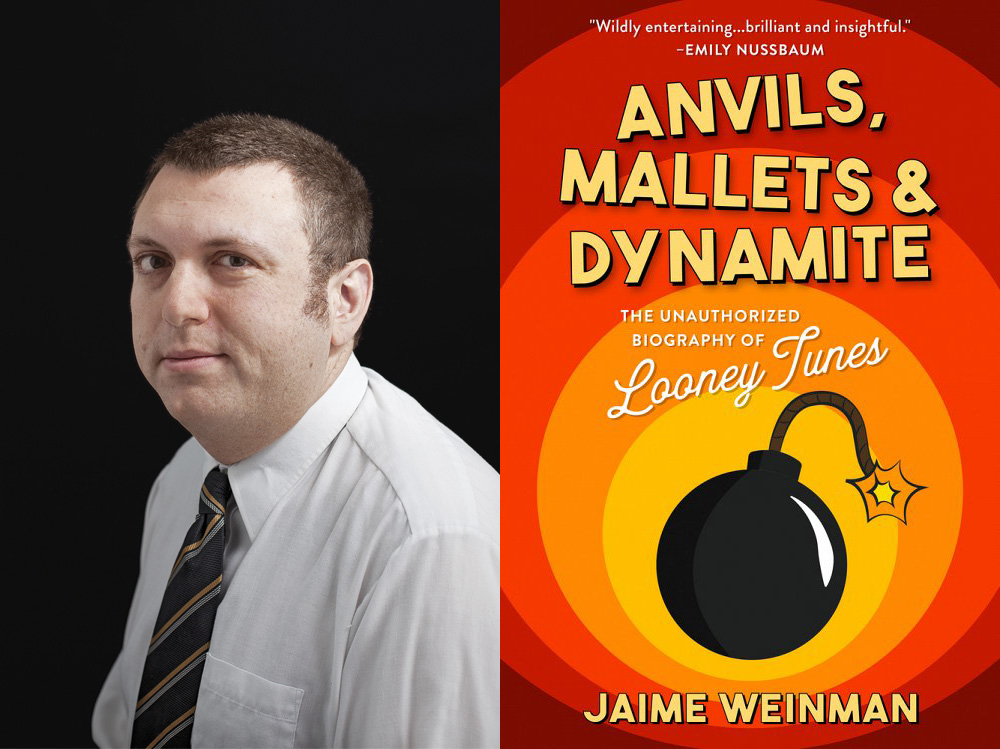


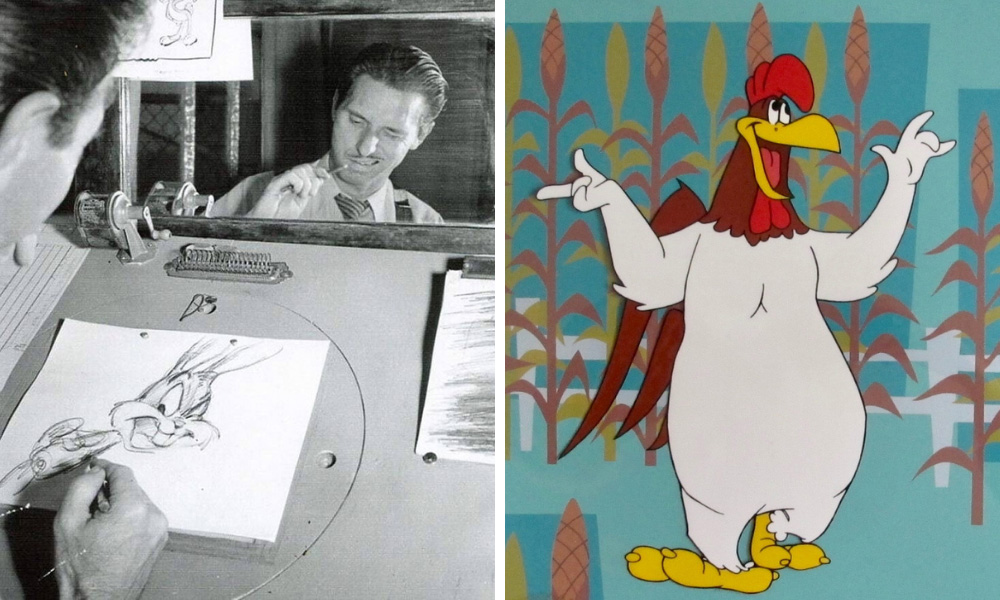

 Win a Funko X Lilo & Stitch Prize Pack!
Win a Funko X Lilo & Stitch Prize Pack! 
